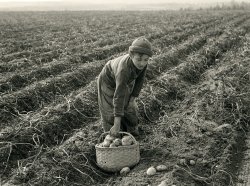
MAY CONTAIN NUTS

Search Shorpy
SHORPY ART

Framed or unframed, desk size to sofa size, printed by us in Arizona and Alabama since 2007. Explore now.
Join and Share
Ad-Free Shorpy
Shorpy is funded by you. Patreon contributors get an ad-free experience.
Learn more.

Recent comments
- If You’re Like Me, Never
- U.S.A.
- S&P
- 1940 Zenith radio model 6G601
- Quality goes in before the name goes on!
- Snazzy skirt
- Carbon Arc Lamps
- Illuminate us
- I remember it well
- I can't prove it
- Complicated then, forgotten now
- Bryan-Stevenson
- Skinny is as skinny does
- How do you rest in peace
- Riding the footboards
- Alas, hidden from view
- Baldwin Diesels
- Exclusive pump
- Bananas, Oysters and Smokey Joe
- Details, Details
- What's that building to the left of the tower?
- Coal Barges
- Bromo-Seltzer
- Inner harbor
- The Basin
- What a headache!
- Giant stepladder?
- Yeah, it was cold
- Love those coats
- Link & Pin Days Remnant
Member Photos
The Shorpy
Print Emporium
Print Emporium
Search Shorpy
Search results -- 30 results per page
- Etna: 1941
- ... Medium format acetate negative by John Vachon for the Farm Security Administration. View full size.
No Known Limit to John ... Posted by Dave - 09/06/2020 - 2:23pm -
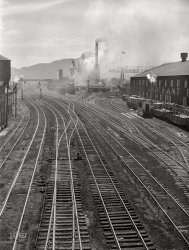
- Rooms for Rent: 1936
- ... California." 4x5 negative by Dorothea Lange for the Farm Security Administration. View full size.
Nostalgia All was not ... Posted by Dave - 06/29/2017 - 6:55pm -
![Rooms for Rent: 1936 February 1936. "Mission District. Slums of San Francisco, California." 4x5 negative by Dorothea Lange for the Farm Security Administration. View full size.
NostalgiaAll was not beautiful in days of yore. Unpainted buildings, dirt, and litter was not a stranger back in the day, but clean laundry was still important!
WonderWonder how they managed to get the washing on the high lines. Step ladder. Trapeze artist. Magic!
[Or just by standing on the balcony. The lines are on pulleys. -tterrace]
Fancy BollardThat bollard-like post seems out of place with the studs, wonder how & who did it?
And in 2017$3000 per month.
$3000 per month is a conservative numberAverage rent for a 1BR in the Mission District as of 5/17 is a hair-raising $3,935.00. Whoa.
Edit: "Solved!" <Trash can or horse post?>I (was) waiting for Shorpyites to identify the two-foot round thing in the lower-right of this picture. It looks like it has rivets on it. Is that another one, farther afield, without rivets?
Edit: Further research indicates that the objects are *re-purposed* water heater expansion tanks, usually filled with concrete, and used to protect private property from stray vehicles. Yes, bollards!
I'm always learnin' something on Shorpy!
(The Gallery, Dorothea Lange, Great Depression, San Francisco)](https://www.shorpy.com/files/images/SHORPY-8b13828a.thumbnail.jpg)
- A Bumper Crop: 1940
- ... Fat Stock Show." Acetate negative by Russell Lee for the Farm Security Administration. View full size.
Dapper dad The suit jacket ... Posted by Dave - 07/15/2021 - 2:18pm -
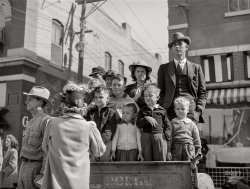
- Big Bruvver: 1941
- ... 1941. "Children outside tent home at the FSA migratory farm labor camp mobile unit. Athena, Oregon." Photo by Russell Lee for the Farm Security Administration. View full size.
Simple pleasures -- few ... Posted by Dave - 05/20/2019 - 8:09pm -
![Big Bruvver: 1941 July 1941. "Children outside tent home at the FSA migratory farm labor camp mobile unit. Athena, Oregon." Photo by Russell Lee for the Farm Security Administration. View full size.
Simple pleasures -- few comfortsNo hot and cold running water; no indoor plumbing; difficult to prepare warm meals; no privacy. Toys were a luxury ...
[The camp had stoves, running water, a laundry, hot showers, a swimming pool and at least one bicycle. Also a boxing ring. - Dave]
Grapes of Wrath sceneWith all the aforementioned amenities, all that's is lacking is a lawnmower or a few goats for mowing duties.
CringeThis brings back vivid memories of the times I rode barefoot and ended up with bloody toes.
Be it ever so humble ...That bicycle is virtually new, so someone was thinking of the children and perhaps some double-duty fun.
(The Gallery, Bicycles, Kids, Russell Lee)](https://www.shorpy.com/files/images/SHORPY-8c01860a.thumbnail.jpg)
- Washings & Iornings: 1939
- ... in washing and ironing." Photo by Russell Lee for the Farm Security Administration. View full size.
Clean and Pressed What ... Posted by Dave - 05/22/2018 - 6:40pm -
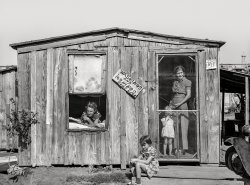
- Greetings From Camden: 1938
- ... New Jersey." 35mm negative by Arthur Rothstein for the Farm Security Administration. View full size.
Who knew? Looks like Camden ... Posted by Dave - 04/27/2008 - 5:03pm -
![Greetings From Camden: 1938 October 1938. "Homes near the gas works. Camden, New Jersey." 35mm negative by Arthur Rothstein for the Farm Security Administration. View full size.
Who knew?Looks like Camden has been the worst place in the world for a good while now.
Oh, Anonymous.You made me laugh out loud.
(Unlike this picture, which is SO depressing...)
The Gashouse GangNo, I'm not referring to the St. Louis Cardinals of 1934, although I understand they got their nickname due to the fact that these large storage tanks were a fixture in many Eastern cities up to the 1950s.
When I was a child, our neighborhood had one that was at least five times the size of this one. I recall it must have been the height of a 30 story building. To call it gigantic might have been an understatement.
Its size always intimidated me; it was an imposing landmark that could be seen for miles around. Up close it made the wooden utility poles beside it look like little toothpicks. The superstructure had pulleys that would allow the tank to expand upward or contract down as the volume of gas increased or decreased.
With the advent of natural gas coming east, these structures became redundant and largely disappeared from the urban landscape.
I've been looking for photos of these tanks; thanks for posting this one.
[Very interesting. So where was it? More pix here and here and here. - Dave]
P.U.There was one in Columbia, SC, when I was a kid. It smelled like a skunk.
Was that there before we went to bed?And who's this Orson Welles fella with all that crazy talk on the radio last night about Martians?
(The Gallery, Arthur Rothstein)](https://www.shorpy.com/files/images/8a10219u2.thumbnail.jpg)
- Don't Stop Believing: 1936
- ... Medium-format nitrate negative by Dorothea Lange for the Farm Security Administration.
Gramma! That look reminds me of my own octagenarian ... Posted by Dave - 03/14/2008 - 12:48am -
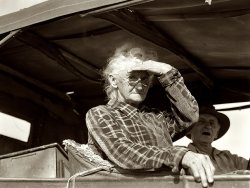
- Pie Town Community Sing: 1940
- ... full size. 35mm nitrate negative by Russell Lee for the Farm Security Administration.
All-Day Sing Everybody looks pretty bored.
... Posted by Dave - 01/16/2008 - 6:27pm -
![Pie Town Community Sing: 1940 June 1940. An all-day community sing in Pie Town, New Mexico. View full size. 35mm nitrate negative by Russell Lee for the Farm Security Administration.
All-Day SingEverybody looks pretty bored.
[But later ... delicious pie! - Dave]
All Day Sing?All day? For real? They sang ALL DAY? Zoinks! They really had to work for that pie!!
Singing StyleDo you think they are singing shaped note or "fa so la"?
I think it's also called Sacred Harp singing. Used to be (still is?) very popular in rural churches: All Day Singing and Dinner on the Ground
likely not shape-notelikely not shape-note or they'd be sitting around the room facing each other (hopefully close to a square).
Bored or hot?I'm not sure they're bored. I think they are about to pass out from the heat. See how wide open those doors are? If you've ever been to New Mexico on a summer day, and had to stand around, without AC, you'd look that way too.
[Pie Town is way up there. Elevation 6,700 feet. - Dave]
(Music, Pie Town, Rural America, Russell Lee)](https://www.shorpy.com/files/images/8a28924u.thumbnail.jpg)
- No Future Here: 1939
- ... comes along for 25 cents an hour. I was raised on a cotton farm my father owned, a little place back there, and I'm plumb willing to leave ... chance to farm. " Photo by Dorothea Lange for the Farm Security Administration. View full size.
Home Having been born and ... Posted by Dave - 05/23/2018 - 7:16pm -
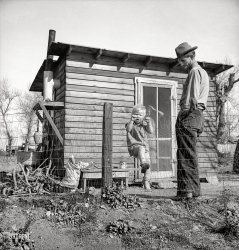
- Slice of Life: 1935
- ... ten people." 35mm nitrate negative by Carl Mydans for the Farm Security Administration. View full size.
Oh how Capitol Hill has ... Posted by Dave - 05/18/2011 - 2:46pm -
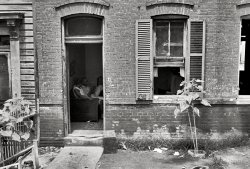
- Night Moves: 1941
- ... Chicago." Medium format negative by Russell Lee for the Farm Security Administration. View full size.
Plymouths and Dodges We see ... Posted by Dave - 12/04/2018 - 5:19pm -
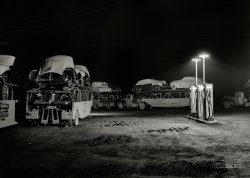
- Wreck on the Highway: 1939
- ... format acetate negative by Marion Post Wolcott for the Farm Security Administration. View full size.
It's for sale This ... Posted by Dave - 04/11/2019 - 10:16am -
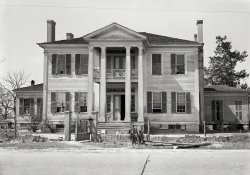
- Free Air, Cash Meat: 1939
- ... New Mexico." Medium format negative by Russell Lee for the Farm Security Administration. View full size.
Signage I shutter to think ... Posted by Dave - 06/15/2018 - 9:01pm -
![Free Air, Cash Meat: 1939 September 1939. "Market and grocery in Questa, New Mexico." Medium format negative by Russell Lee for the Farm Security Administration. View full size.
SignageI shutter to think what a picker wold pay for all those signs.
[It's "shudder." - Dave]
Equal relief for men & ladiesIf the meat or vegetables are not all that fresh and end up causing digestive problems, thankfully there are two outhouses to run to at the back of the grocery shop.
Fully equippedFully equipped with all the modern conveniences... including facilities for Men and Ladies out back.
I wonder why they were called 'Cash Markets'?In the town where I grew up there was a small store a couple of blocks from us, called "Scotties' Cash Market". It was was pretty small, but it had a lot of stuff packed in that space. Did a good business in the 1960s, but died a slow death in the 1970s when two things happened: (a) the town turned the street it was on (the Main Street) from two lanes with parking into four lanes and banned parking, and (b) a 7-11 clone opened down the street with off-street parking.
[It means you can't buy on credit or run up a tab. - Dave]
AvalonYou’d never guess they cost you less.
Everything a road traveler could need or wantOne very well stocked roadside market, cigarettes, tobacco, rolling papers, bags of flour, Coca Cola, free air and comfortable rest rooms.
Those OuthousesI hope the meat coolers were on the other side of the store.
Shorpy Parade of Pickups PastAbout a 1935 Dodle. If you go much earlier in the 30s, the Dodles I can find pictures of had rear-hinged "suicide" doors, at least on the driver's side. Of course, it's possible that Fiat Mercedes-Benz Chrysler Dodge Brothers built a pickup with a suicide driver's door and a regular passenger door, to clear the spare tire -- that would be a very Chrysler thing to do.
(The Gallery, Russell Lee, Small Towns, Stores & Markets)](https://www.shorpy.com/files/images/SHORPY-8b22879a.thumbnail.jpg)
- Guitar Hero: 1939
- ... Medium format safety negative by Russell Lee for the Farm Security Administration.
Air Guitar Must be for playing "air guitar" ... Posted by Dave - 04/02/2008 - 4:43pm -
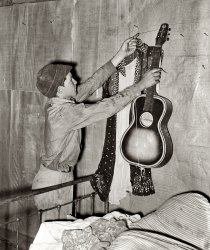
- The Singing Cowboys: 1939
- ... Medium format acetate negative by Arthur Rothstein for the Farm Security Administration. View full size.
Somebody tell me that's not ... Posted by Dave - 04/09/2018 - 11:24am -
![The Singing Cowboys: 1939 June 1939. Big Horn County, Montana. "Cowhands singing after day's work. Quarter Circle U Ranch roundup." Medium format acetate negative by Arthur Rothstein for the Farm Security Administration. View full size.
Somebody tell methat's not Gary Cooper in the center.
Well thenThat means that Harry Carey is sitting just to his left. Maybe it's a Ford Production.
[Harry Carey Jr., maybe. -tterrace]
Indeed, my error!
Clever flash placementIt even appears to be further concealed with propped-up firewood. And I bet everyone but the harmonica player was vision impaired for the rest of the evening!
And on guitarWalter Cronkite.
[I see Preston Foster. -tterrace]
Preston on tenorThat's an interesting guitar that Preston Cronkite is playing. It's a 12-fretter (the body join is at that fret rather than the 14th fret that is more often seen nowadays) tenor guitar. Doesn't look like a Martin to me, as the soundhole rosette is fancier than the top binding would dictate. Maybe a Harmony. No pickguard.
I've owned a couple of old tenor guitars and never could decide how to tune the darned things. His is likely tuned as a regular guitar (EADG strings only), as he seems to be fingering a G chord. Most players tuned them like a tenor banjo (CGDA), I believe.
The fellow on the left may be playing harp, so let's call him Harpo.
SuddenlyI want a Marlboro.
Quarter Circle UNice article with more photos and history of this and other Montana ranches.
(The Gallery, Arthur Rothstein, Camping, Frontier Life)](https://www.shorpy.com/files/images/SHORPY-8b18183a.thumbnail.jpg)
- Local Characters: 1938
- ... Medium format negative by Arthur Rothstein for the Farm Security Administration. View full size.
What is, what was Looks as ... Posted by Dave - 11/27/2017 - 11:43am -
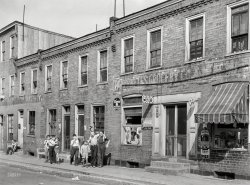
- This Won't Hurt a Bit: 1943
- ... size. 4x5 Kodachrome transparency by John Vachon for the Farm Security Administration.
She's being so BRAVE! Her red hair and ... Posted by Dave - 08/10/2012 - 4:15pm -
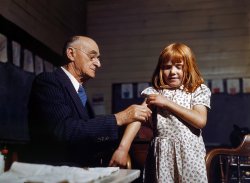
- Badland: 1939
- ... Medium format negative by Marion Post Wolcott for the Farm Security Administration. View full size.
Duplicate? This seems to be ... Posted by Dave - 05/05/2019 - 12:05pm -
![Badland: 1939 September 1939. "Ducktown, Tennessee. Train bringing copper ore out of mine. Fumes from smelting copper for sulfuric acid have destroyed all vegetation and eroded the land." Medium format negative by Marion Post Wolcott for the Farm Security Administration. View full size.
Duplicate?This seems to be the same MPW photo posted under the caption, “The Wasteland” a couple days ago. Maybe this is a different image, as I have not compared them side by side.
[That would be less trouble than leaving a comment, wouldn't it? - Dave]
FumesThey didn’t do wonders for the Ducktown inhabitants either; a Navy shipmate was from Ducktown, and he had major COPD at age 35, followed by a fatal heart attack a year later.
Not a resortIt looks like the land is still scarred. Here's an overhead view of the area northeast of Ducktown, near the Burra Burra mine. While the area has some vegetation, it still looks pretty bare. I wouldn't go near the lake to the west.
Now?I've seen a lot of things on Shorpy but the devastation seen here is astonishing. It looks to be many many square miles no doubt in all directions from the mine. I'm wondering what it might look like now, was there recovery?
To State the ObviousThis photo has a happy choo-choo that seems not to know the sorrows of air laden with sulfuric acid. The other doesn't.
51 Years LaterI drove through Ducktown in 1990. It didn't look anything like this.
Road sign said, "Ducktown, A quacking nice town."
Lasting scarsAbout 1978 I drove a cousin from Knoxville to an interview for a teaching position in nearby Copper Hill. The school sat all alone on a hilltop, with a 360-degree view very much reminiscent of this image. The superintendent who conducted her interview asked her if she "really wanted to commit to a place that looks like this?" She is eternally grateful to him for that question, because the answer was a resounding "No."
(The Gallery, Landscapes, M.P. Wolcott, Mining, Railroads)](https://www.shorpy.com/files/images/SHORPY-8c10632a.thumbnail.jpg)
- Terry's Coffee Shop: 1941
- ... format acetate negative by Marion Post Wolcott for the Farm Security Administration. View full size.
Great name for a coffee shop ... Posted by Dave - 06/20/2021 - 9:53pm -
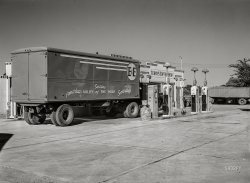
- Telluride: 1940
- ... Colorado." Medium format negative by Russell Lee for the Farm Security Administration. View full size.
This Property is Condemned. ... Posted by Dave - 09/30/2018 - 7:49am -
![Telluride: 1940 September 1940. "Dilapidated buildings at Telluride, Colorado." Medium format negative by Russell Lee for the Farm Security Administration. View full size.
This Property is Condemned. Part OneJust needs a leading man in the scene. Replayed everywhere in the USA.
It's all in how you say itA certain conductor, as his Rio Grande Southern train approached the town, would go through the coach and announce the next stop as, "To Hell You Ride".
Our young damsel in the photo looks like she'd rather be somewhere else. Hope she's in a better place now.
705 is really 205The address sign that looks to me like "705" is probably really "205." As in 205 E. Colorado Avenue. The vacant building with the suspicious young lady sitting in front is now gone, and they seem to have raised the street level, but the shop to the left is still there. In the 2014 Google view it's the "Telluride Music Co." but appears to be a cafe now. You might still be able to get a Big Smile there, but these days that might mean putting something... different in your pipe.
Phoenix BeanThis building looks to me like the current Phoenix Bean coffee shop (image below). It was originally a hardware store.
[This is the building to the left, with the SHERIDAN BEER sign in the window. - Dave]
Google and Bing say "no"I thought it would be interesting to see if these buildings survived the "gentrification" of Telluride after it became a ski resort, however, neither Bing nor Google maps have street view in Telluride. Hard to believe, but true.
Except for one small strip of Colorado Avenue (about a block) Google does not show any streetviews for Telluride in my Google in Indiana. Yet I see one below. WTF Google in Indiana?
Been to Telluride It's come up in the world.
NestsOn the more ornate building there a few nests above the girl. I will guess they are from wasps but the opening looks different than what I usually see.
[Those are swallow nests. Made by birds, not bees. - Dave]
(The Gallery, Russell Lee, Stores & Markets)](https://www.shorpy.com/files/images/SHORPY-8b26105a.thumbnail.jpg)
- Chicago Commuters: 1941
- ... trains." 35mm acetate negative by John Vachon for the Farm Security Administration. View full size.
One hard brim boater Among ... Posted by Dave - 09/23/2020 - 1:06pm -
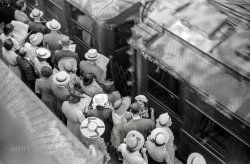
- Inflationary Pressure: 1936
- ... Louisiana." 35mm nitrate negative by Russell Lee for the Farm Security Administration. View full size.
Look at the bright side ... Posted by Dave - 08/13/2013 - 3:39pm -
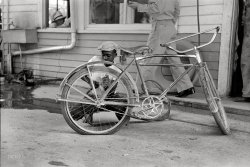
- Club Med: 1937
- ... Medium format nitrate negative by Arthur Rothstein for the Farm Security Administration. View full size.
Liv-o-Med Looks like it ... Posted by Dave - 04/18/2018 - 12:05am -
![Club Med: 1937 February 1937. "Abandoned house on the Withlacoochee Land Use Project, Florida." Medium format nitrate negative by Arthur Rothstein for the Farm Security Administration. View full size.
Liv-o-MedLooks like it took care of just about everything--even biliousness!
Any "colorizers" out there looking for a little something to do?
Three Sixes for malaria?Is that "Malaria" on the partially-obscured 666 (called "Three Sixes" in their radio ads) sign? I've always seen the "COLDS FEVER" signs, but I never heard them make a claim for curing malaria.
Also, I would be particularly interested in the dirt track racing at the Florida State Fair, but sadly, that was last year's (the 1936) fair.
Black-DraughtToo graphic for my sensibilities!
Royal American ShowsOnce the largest Midway provider in North America with a 60 car train to transport the rides and various games and booths. Out of business by the 70's but my childhood remembers them well.
The sign they needed most?Post no bills.
[Or: BOAST NO PILLS. - Dave]
Stop or I'll Dazzle!Is that a row of bottle caps nailed to the board bottom left of the house--a makeshift guardrail or just for show?
Now that's forward thinking!On the left side of the house below the 666 for colds and fever sign is a lonely poster advertising the 1938 Fair Feb 4 to 15. Only a year in advance. Now that's planning!
[It's actually an old sign for the 1936 fair. -tterrace]
(The Gallery, Arthur Rothstein, Florida)](https://www.shorpy.com/files/images/SHORPY-8b35760a.thumbnail.jpg)
- Make It Stop: 1939
- ... Pacific Challenger ." Photo by Dorothea Lange for the Farm Security Administration. View full size.
Challengers The Challenger ... Posted by Dave - 04/25/2018 - 8:13am -
![Make It Stop: 1939 June 1939. West Carlin, Nevada. "Brakeman on the Union Pacific Challenger." Photo by Dorothea Lange for the Farm Security Administration. View full size.
ChallengersThe Challenger passenger trains were really jointly operated by three railroads. The Chicago & North Western, the Union Pacific, and the Southern Pacific.
The route through Carlin was off UP track, and onto the SP's. I spent some time in Carlin, not long after this shot was made, and I can tell you that the trains passing through town were almost certain to be the daily highlight to a young boy. Glad I like trains, I was.
[Our brakeman is wearing a UP uniform. - Dave]
What you write eventually was true. But, in the time of the photo, and during my youth, the shared track was owned by the Western Pacific, and only came under the UP's ownership when they absorbed the D&RGW, which had earlier gobbled up the WP. Of course, it all belongs to the UP now.
I don't know the operating arrangement, but it could well be that the UP supplied through crews for the train.
[Before Union Pacific acquired Southern Pacific in 1997, the two railroads operated separate tracks across northern Nevada. Between Weso, just east of Winnemucca, and Alazon, to the east of Elko, UP and SP operated dual trackage, with westbound traffic moving on one line and eastbound on the other. More on the Union Pacific Challenger. - Dave]
The man takes pride in his work. Vest watch, creased trousers, shined shoes, with a shave.
What is he holding in his left hand?
First Transcontinental RailroadThis man is standing on the roadbed the Central Pacific built for the transcontinental railroad, which met the Union Pacific north of Salt Lake City. Southern Pacific acquired the Central Pacific through land leasing in 1885. Union Pacific purchased Southern in 1998.
The thing in his left handThat container could be holding flares or railroad torpedoes.
Flagging KitHe's holding a standard flagging kit, the larger diameter tube in the foreground holds fusees (flares to some), the smaller diameter tube on the far side holds the flag when not in use. Like many trainmen, he has wrapped a number of track torpedoes (explosive devices that make a very loud sound when a train rides over them, but don't damage the track or wheel) on the smaller tube to make them easy to get to.
Challengers of Two TypesThe Union Pacific had both passenger trains and locomotives called Challengers. As far as I know, the two were not necessarily associated with each other. A Challenger (locomotive) might pull a Challenger (passenger train) over part of the trip.
Length of serviceWould the three bars on his sleeve indicate the length of service on the UP?
(The Gallery, Dorothea Lange, Railroads)](https://www.shorpy.com/files/images/SHORPY-8b33533a.thumbnail.jpg)
- Scenic Route: 1941
- ... street." Medium format negative by Jack Delano for the Farm Security Administration. View full size.
"Credit" cards I ... Posted by Dave - 02/02/2019 - 4:40pm -
![Scenic Route: 1941 September 1941. "Tunbridge, Vermont -- the main street." Medium format negative by Jack Delano for the Farm Security Administration. View full size.
"Credit" cardsI grew up in the late '40s and early '50s in Anaheim. I always remember that my parents always and only purchased Mobilgas. They used an "IBM" punch card with their name and account data. You'd give the attendant the book of IBM cards, they'd enter the amount and $, Mom or Dad would sign the card, tear it off the stub and give it to the dealer. As I recall this was Mobil Oil's credit system all the way into the 1960s, maybe slightly longer. A statement would come in the mail and payment was made by check in a return envelope.
Streetview vs DelanoThe Delano picture is classic Norman Rockwell, while Google Streetview is depressing rural America that could easily be West Virginia or Pennsylvania. The interesting thing is that, unlike a lot of Shorpy, most of the buildings in the Delano shot are in the Streetview shot (the dilapidated building on the left is gone).
But Delano is using a lens that puts the buildings closer together than what we see in Streetview, and the gas station signs -- which would have been considered defacement of proud colonial buildings in 1940 -- look quaint to our eyes. Also, we sense an active community life in the Delano pictures. Tunbridge 2012 just looks dead (and defaced by some unfortunate post-1940 modifications).
Photography is art -- not just representation. Here lives an example of that.
The competitionI wonder if the Hutchinses of the grocery store and the Pattersons of the general store were friendly-like to each other.
Tunbridge Today
Real Ice CreamI'm glad to see Patterson's general store is serving real ice cream and not that fake stuff.
Credit Cards, in 1941?The biggest surprise for me is that Mobilgas accepts credit cards! I did not realize there were credit cards in 1941. I was born in 46, and don't remember my parents having a credit card before the late '50s early '60s!
[Retail merchant credit cards (as opposed to general purpose bank cards) got their start in the 1920s. - Dave]
VT 110Apparently the Vermont Route 110, scenic for the many covered bridges I suppose. The Howe, Cilley, Mill, Larkin and Flint Covered Bridges in the Tunbridge Village Historic District.
And did you know that Tunbridge has its own World's Fair?
(The Gallery, Gas Stations, Jack Delano, Small Towns)](https://www.shorpy.com/files/images/SHORPY-8c07006a.thumbnail.jpg)
- The Lonesome Road: 1941
- ... Medium format negative by Marion Post Wolcott for the Farm Security Administration. View full size.
Still a lonely place So ... Posted by Dave - 09/06/2019 - 7:01pm -
![The Lonesome Road: 1941 August 1941. "Road with Homestead, Montana, and grain elevators on the horizon." Medium format negative by Marion Post Wolcott for the Farm Security Administration. View full size.
Still a lonely placeSo isolated that even Google has not visited.
The grain silos appear to be present (there is no "street view"). The road is "Homestead Rd"/County Route 350 you are looking eastward towards Homestead.
I don't know where these folks shop for groceries -- the nearest town of any size, with stores, is Williston, North Dakota. Very isolated.
[They shop here. -Dave]
I can hear it nowAre we there yet?
Where's the curve?The photo had to be taken looking east from Route 350 west of Homestead, but there's no curve in the road now. Two of the grain elevators are still there.
Lonely RoadIndeed - hasn’t changed.
Try the Great Basin - More nothing.
Pole Pecker Trouble A woodpecker, on the pole nearest. Its mere presence disturbs the peace.
What's That in the Road? A Head?Whatever it is must be about 12 miles away
(The Gallery, Landscapes, M.P. Wolcott, Railroads)](https://www.shorpy.com/files/images/SHORPY-8c35941a.thumbnail.jpg)
- Bring the Kids: 1938
- ... View full size. Photo by Russell Lee for the Farm Security Administration.
Fab Fedora Love the hat.
The Clothes Make ... Posted by Dave - 06/03/2008 - 11:13am -
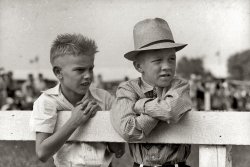
- Corn-Fed: 1941
- ... Vermont." Medium format negative by Jack Delano for the Farm Security Administration. View full size.
Pursed lips I like the way ... Posted by Dave - 07/31/2019 - 8:34pm -
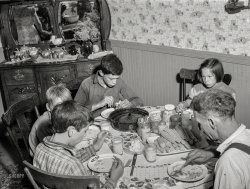
- H.V. Bretney: 1938
- ... Ohio." 35mm nitrate negative by Ben Shahn for the Farm Security Administration. View full size.
Fresh Air Have you ever ... Posted by Dave - 09/26/2014 - 3:08pm -
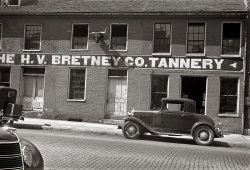
- YouTubers: 1940
- October 1940. "Boy picking potatoes on a large farm near Caribou, Maine. Schools do not open until the potatoes are ... Medium format negative by Jack Delano for the Farm Security Administration. View full size.
Taters The caption under this photo ... Posted by Dave - 05/15/2019 - 2:01am -
